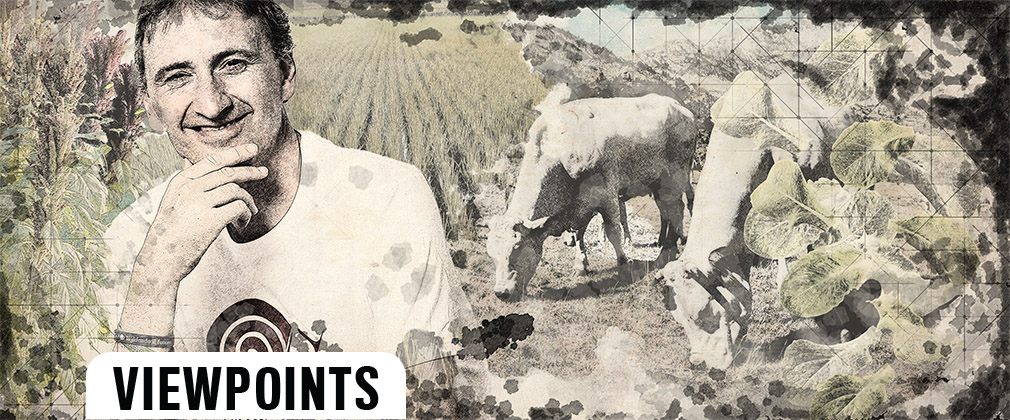Paolo di Croce: Biodiversity is Essential
BALTIMORE—April 13, 2022. Paolo di Croce sees tragedy in our current food system, but he’s also optimistic about the changes he sees underway. When people push aside their local foods in favor of cheaper, industrial, less nutritious, and environmentally costly products—that’s tragedy. But he also sees people re-connecting with the act of eating and getting curious about the story behind their food—that makes him hopeful.
As international secretary of the Slow Food International Board of Directors, he is part of a movement that wants to help local partners and producers around the world grow and eat food that is traditional to their cultures, identities, and economies. His personal mission is also the Slow Food mission, which embraces biodiversity, food sovereignty, and a revival of traditional foods. And the mission indirectly speaks to climate change, as well, because foods that are traditional in a region are often well-adapted to the ecosystems that host them.
He gives the example of amaranth, which provides a lot of nutrients and requires very little water to grow—perfectly suited for climates in Mexico. It was once a staple there, but it was supplanted by cheap commodity crops imported from the United States, such as corn and rice, which require a lot of water yet provide fewer nutrients. As the imports became popular, amaranth growers were put out of business. There has been a resurgence of interest in it, however, which makes him optimistic. Finger millet is another traditional food that’s well-suited for its Senegal environment but has been displaced. Another tragedy di Croce describes is the unintended consequence of humanitarian food aid. Of course, food aid is necessary sometimes, and is full of good intentions. But it can create problems, and he gives an example: East Africa used to rely on nutrient-rich, green, leafy vegetables, but food aid, in the form of lettuce, replaced the leafy greens and resulted in a less healthy diet for East Africans.
Di Croce believes that local people should own their food production and have the freedom to choose food that’s meaningful to them, and pleasurable to eat.
“You shouldn’t have to eat imported food because it’s cheap,” he says. “As Westerners, we don’t need to export, we need to create conditions to raise awareness and build local leaders and knowledge.”
Alarmingly for di Croce, local cultures are forgetting about their traditional foods and how to grow them. In part, this is a public relations problem, as Westerners have de-valued traditional foods throughout the Global South. During an exercise in West Africa to produce a booklet of local recipes, he and his Slow Food team found that when they asked locals about their traditional foods, they were reluctant to name them.
But when he and his team asked, “When there is a wedding, what do you eat?” they got a long list of responses.
If we can achieve biodiversity in food, he says, we can contribute to the health of wild forests, wild oceans, and other wild ecosystems—all of which work to reduce the impacts of climate change. And he is a strong believer in agroecology as an essential solution.
“Agroecology is the only option for our planet,” he says, “and animals are a fundamental component of agroecology.” We do need to reduce the amount of meat that we consume, he says—twice a week might be ideal. “We respect all decisions, of course,” he says.
Many skeptics respond to ideas like di Croce’s by asking, “But will it scale?” Our current hyper-industrial food system has been fueled, in part, by a near-hysteria about needing to scale production in order to feed 10 billion people by 2050. But di Croce thinks that industrial-scale production is not the only way.
“We have to be very careful about the consequences for thousands of people who will suffer if they have to depend on commodity crops,” he says.
His vision is a world in which everyone is able to eat what Slow Food calls “good, clean, and fair” food. “Good” refers to taste and quality. “Fair” refers to affordability, and the ability of producers to earn a living. And by “clean,” he means food that does not harm the environment, that preserves soil, water, and climate. “We’re happy about organic, but ‘clean’ doesn’t necessarily mean organic,” he says. “A massive monoculture of tomatoes is not clean, even if the tomatoes are organic.”
When Slow Food was founded, its guiding principle was pleasure, and that idea still serves as the foundation for the organization. Di Croce explains that there are two elements to pleasure when eating: responsibility and availability. It should be available to everyone, and it should exploit no one. There’s an idea in some cultures, he says, that food is fuel, and that we eat it to power our bodies. “But food is not fuel,” he says. “I think that’s sad.”
“Food is culture,” he says, “and I think in the younger generation, ideas are changing. When people buy food, they’re paying more attention to quality and diversity. They want to know the story of their food. The producers who bring us traditional foods can never compete with the big corporations on price, they will always lose on price—but they can compete on quality.”
For more perspectives on food system reform, check out the CLF Global Thought Leaders Series.
Illustration by Mike Milli, 2022.
